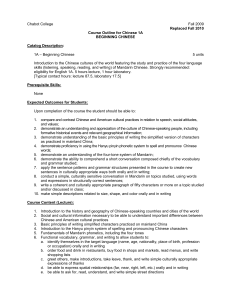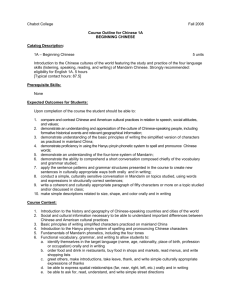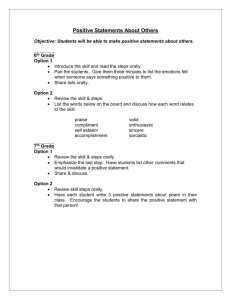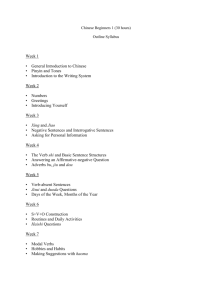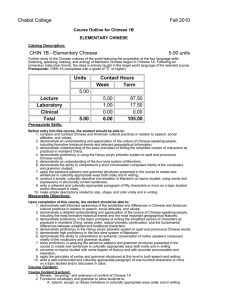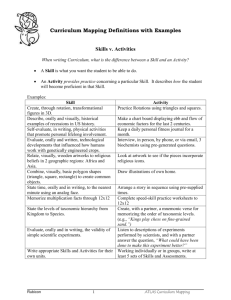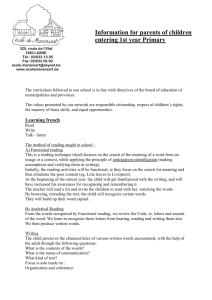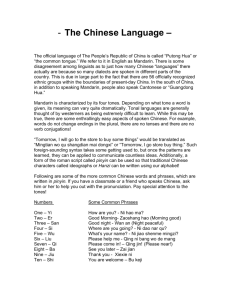Chabot College Fall 2010 CHIN 1A - Beginning Chinese 5.00 units
advertisement
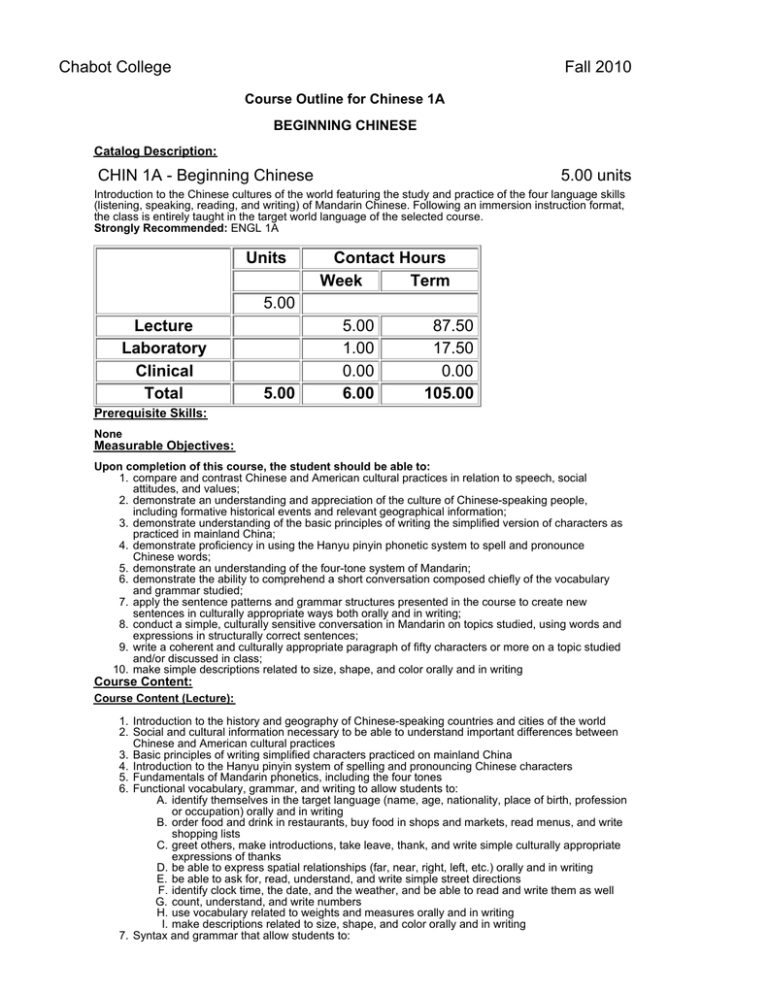
Chabot College Fall 2010 Course Outline for Chinese 1A BEGINNING CHINESE Catalog Description: CHIN 1A - Beginning Chinese 5.00 units Introduction to the Chinese cultures of the world featuring the study and practice of the four language skills (listening, speaking, reading, and writing) of Mandarin Chinese. Following an immersion instruction format, the class is entirely taught in the target world language of the selected course. Strongly Recommended: ENGL 1A Units Contact Hours Week Term 5.00 Lecture Laboratory Clinical Total 5.00 5.00 1.00 0.00 6.00 87.50 17.50 0.00 105.00 Prerequisite Skills: None Measurable Objectives: Upon completion of this course, the student should be able to: 1. compare and contrast Chinese and American cultural practices in relation to speech, social attitudes, and values; 2. demonstrate an understanding and appreciation of the culture of Chinese-speaking people, including formative historical events and relevant geographical information; 3. demonstrate understanding of the basic principles of writing the simplified version of characters as practiced in mainland China; 4. demonstrate proficiency in using the Hanyu pinyin phonetic system to spell and pronounce Chinese words; 5. demonstrate an understanding of the four-tone system of Mandarin; 6. demonstrate the ability to comprehend a short conversation composed chiefly of the vocabulary and grammar studied; 7. apply the sentence patterns and grammar structures presented in the course to create new sentences in culturally appropriate ways both orally and in writing; 8. conduct a simple, culturally sensitive conversation in Mandarin on topics studied, using words and expressions in structurally correct sentences; 9. write a coherent and culturally appropriate paragraph of fifty characters or more on a topic studied and/or discussed in class; 10. make simple descriptions related to size, shape, and color orally and in writing Course Content: Course Content (Lecture): 1. Introduction to the history and geography of Chinese-speaking countries and cities of the world 2. Social and cultural information necessary to be able to understand important differences between Chinese and American cultural practices 3. Basic principles of writing simplified characters practiced on mainland China 4. Introduction to the Hanyu pinyin system of spelling and pronouncing Chinese characters 5. Fundamentals of Mandarin phonetics, including the four tones 6. Functional vocabulary, grammar, and writing to allow students to: A. identify themselves in the target language (name, age, nationality, place of birth, profession or occupation) orally and in writing B. order food and drink in restaurants, buy food in shops and markets, read menus, and write shopping lists C. greet others, make introductions, take leave, thank, and write simple culturally appropriate expressions of thanks D. be able to express spatial relationships (far, near, right, left, etc.) orally and in writing E. be able to ask for, read, understand, and write simple street directions F. identify clock time, the date, and the weather, and be able to read and write them as well G. count, understand, and write numbers H. use vocabulary related to weights and measures orally and in writing I. make descriptions related to size, shape, and color orally and in writing 7. Syntax and grammar that allow students to: A. B. C. D. identify correct word order in a Chinese sentence read, enunciate, and write simple descriptive sentences (Wo lei./Ta hen mang) read, enunciate, and write ascriptive sentences using the verbs “shì” and “xíng “ read, enunciate, and write verbs-of-action to describe habit or action (Ta kàn bào./Wo bùhé chà.) E. read, enunciate, and write verbs-of-existence (zhù, zài, zhùzài) to indicate location of subject F. use adverbs of time in proper sentence position orally and in writing G. combine verbs-of-motion and verbs-of-action to describe motion, destination, and purpose (Wo qù shangdìan mai bi) orally and in writing H. ask grammatically affirmative and negative questions orally and in writing I. create sentences with “you” and its negative form “méiyou” to indicate possession or existence and their negative equivalents orally and in writing J. use the verb “zài” to indicate the location of an event orally and in writing K. use the verb “gei” to indicate favor or offering orally and in writing L. use expressions of quantity and measure orally and in writing M. use “de” to indicate ownership, condition, or color orally and in writing N. use the “co-verb” for the verb of motion “lái/qù” to describe movement orally and in writing Course Content (Laboratory): 1. Activate lecture content using interactive audio and audiovisual programs on CDs, DVDs, CD ROMS, target language websites, etc., featuring culturally authentic and contextual guided speaking, reading, and writing activities such as cued repetition of native speech, dictations, cued oral responses, listening comprehension, and interactive realia (culturally authentic texts). 2. Organized laboratory activities including conversation groups. 3. Laboratory Assignment: Hanyu Pinyin drill: A. Practice pronunciation of the symbols for 23 consonants, 6 single vowels, and 18 compound vowels B. Practice intonation of the different tone marks C. Practice syllables formed by blending a consonant and a vowel or a compound vowel D. Practice the exceptions to standard rules for Hanyu Pinyin. Methods of Presentation 1. 2. 3. 4. Lecture/discussion and question/answer in target language Choral/individual repetition of model speech Re-creation of dialogues and improvisation Small group activities leading to skits, dialogues, etc. Assignments and Methods of Evaluating Student Progress 1. Typical Assignments A. Demonstrate greeting skills in a skit taking place in an airport, train station, etc. B. Write a brief paragraph that includes biographical information, such as nationality, place of birth, birthday, and current residence C. Practice writing the characters learned in a given class D. Laboratory Assignment: Make a recording of the poem “Thoughts on a Still Night” by Li Bai. 2. Methods of Evaluating Student Progress A. Tests, quizzes, and interviews to evaluate the four language skills and cultural sensitivity in relation to material presented B. Student participation in class activities C. Graded homework assignments D. Recordings from the language laboratory to evaluate pronunciation skills E. Final Examination Textbooks (Typical): 1. Tao-Chung Yao (2008). Integrated Chinese (2nd/e). Boston Chen & Tsui Company. 2. Workbook/Character Workbook/Audio CDs Lab Version, 3rd edition, Level 1, Part 1, to accompany Integrated Chinese. Special Student Materials
